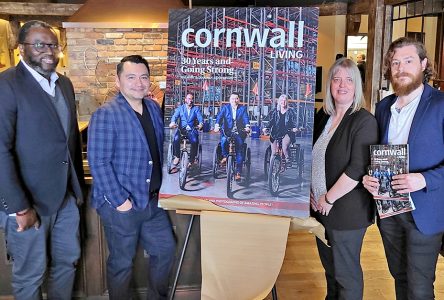Wind, rain, and the occasional snowflake couldn’t stop a group of volunteers from practicing good stewardship in the Thousand Islands. On Tuesday, February 21st the Thousand Islands Land Trust (TILT) and Save The River (STR) hosted a group of scouts and their families on TILT’s newly conserved Blind Bay Preserve.
Joined by their families, the members of Pack 55 and Troop 55 of Fort Drum braved the inclement weather to make a difference for migratory birds in the Thousand Islands. Groups worked with TILT and STR staff to install songbird nest boxes throughout the upland hardwood forest of the Preserve while members of Troop 55 took to the waters edge to install wood duck nest boxes. A flock of long-tail ducks could be seen in the distance at the icy edge of the bay, a sign of this area’s year-round importance to waterfowl.
Last autumn, TILT officially purchased the 20.5 acre Blind Bay Property located along Waters Edge Lane in the Town of Orleans from Blind Bay Associates. Combined with TILT’s prior conservation investment of adjacent lands, the Blind Bay Preserve now includes approximately 36 acres of mixed hardwood forest and over 895 feet of undeveloped shoreline, consisting of pristine open water and emergent wetlands.
Blind Bay is a historic breeding grounds for muskellunge and 53 other aquatic species. In early 2021, Customs and Border Protection (CBP) announced that they had identified Blind Bay as a preferred site for their new Thousand Islands facility. STR, TILT, Thousand Islands Park (TI Park), Thousand Islands Association (TIA) and several other organizations were joined by over one thousand residents and concerned community members in expressing their opposition to the location of an industrial style facility on this pristine site. Lauren Eggleston, Save The River’s Assistant Director, pointed out, “if we lose spawning areas such as Blind Bay, the River will not continue to be the incredibly diverse ecosystem that we know today. The River and its environment are under a lot of pressure from pollution, development, and aquatic invasive species.”
But it wasn’t all work and no play for the volunteers. While working to install the nest boxes, the scouts had plenty of time to learn and explore the variety of habitats the Preserve supports. From investigating fungi on logs to accidentally flushing a ruffed grouse from its hiding place, the scouts learned all about the native flora and fauna that call Blind Bay home. The upland section of Blind Bay is home to many species of birds, reptiles, insects and a variety of native plant species grow here, making it an ecologically valuable property to conserve now and for generations to come. Echoing this sentiment, Save the River’s Education Coordinator, Robin Hall, said, “Blind Bay is an important environmental asset to the Region. By having the scouts here today, we’re educating the next generation of environmental stewards.” Echoing these sentiments, TILT’s Stewardship Director, Ken Nims stated, “Blind Bay Stewardship Day highlighted the importance of community involvement in conservation efforts in the Thousand Islands. TILT’s ongoing commitment to safeguard the regional landscape is further strengthened with the outpouring of support we receive from our local community.”
Blind Bay is located within the core of the Algonquin to Adirondack wildlife corridor (A2A) and is situated along the Atlantic Flyway, a migratory path for a significant number of bird species. “With habitat loss being a major contributor to alarming declines in bird populations, the conservation of this property is already a major asset to numerous species as a place to stopover during migration, forage for food, or breed. Today, we’re helping them out a little more by installing nest boxes that can be utilized by many species as a safe place to raise their young,” said TILT’s Land Protection Specialist, Nate Helmuth.
By the end of the day, most of the volunteers were sporting soggy mittens and rosy cheeks. Looking around at all of the smiling faces, Rachel Zalewski, Pack 55 Leader, noted that, “conservation and scouting go hand in hand as far back as the 1900s. It is part of a Scout’s Outdoor Code. As scouts we recognize our duty to work hard to conserve wildlife, energy, forests, soil and water. It is our future and our responsibility to do our part as stewards of this world; especially our local community and its environment. We want to set a good example for the younger generation and encourage these amazing opportunities in our communities.”
To learn more about Blind Bay and how you can help, visit the Save Blind Bay website at SaveBlindBay.com



